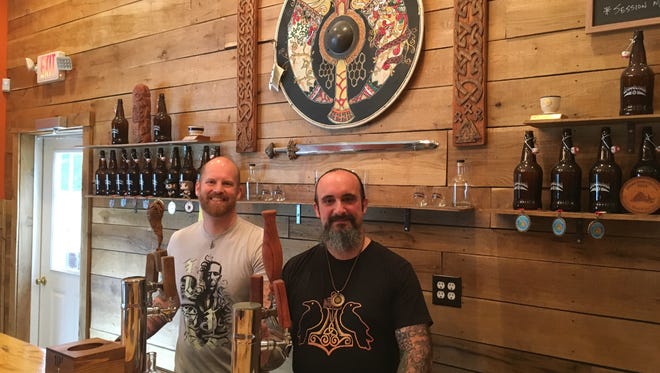Brimming Horn Meadery brings a ‘gift from the gods’ to Lewes

It was a little after 2 p.m. on a Friday when people started showing up at the Brimming Horn Meadery in Milton.
Drinkers have been finding their way here since the place opened earlier this summer, half out of excitement and half out of curiosity.
If you’re confused by the seemingly recent proliferation of mead, you’re not alone.
According to Jon Talkington, one of the owners of the Brimming Horn Meadery, mead is undergoing a meteoric growth spurt that puts what happened in craft beer over the last few years to shame. While mead won’t ever get as big as craft beer, Talkington said it is retaking its rightful place as a stable alcoholic beverage.
Talkington was already a talented mead maker before he was old enough to buy beer.
As a child in rural Ohio, Talkington was fascinated by myths and was fortunate to have a teacher point him in the right direction.
“I had a science teacher, and she had made mead,” Talkington said. “There was a recipe for Simmis in a Scandinavian cookbook that was in the library.”
Sure beer, wine and spirits are all mentioned throughout mythology, but by the time a person is old enough to read, say, "Beowulf," they have encountered beer, wine and spirits.
Mead is a thing unto itself in mythological literature, Talkington said. A drink of the gods, but made by people.

Growing up, Talkington said his family made their own wine and were friendly with people who dabbled in making their own beer.
The making was the thing, he said, much more than the alcohol was. This explains why his parents barely raised an eyebrow when their 16-year-old son’s interest in his Nordic ancestry ended with making mead.
Before he was 20, Talkington was making regular trips to the homebrew store to perfect his craft. He found work at a winery and eventually made it on Delmarva where he started brewing beer at Dogfish Head.
He continued to be part of the mead making culture, both online and in person, earning awards and becoming a master of the craft over the ensuing decades.
A few years ago, a mutual friend introduced Talkington to J. R Walker. With their Norse tattoos and necklaces, the pair looked as if they already ran in the same circles. So, going into business together wasn’t too far of a jump.
Walker, an entrepreneur, was working on developing an all-you-can-eat ice cream buffet when he and Talkington decided to open a meadery.
Walker’s expertise is in logistics and execution. The deal was simple: Talkington would make the mead while Walker handled the paperwork, permitting, distribution and the rest of the business end.
That included cultivating a market, which wasn’t an easy task.
Mead's lack of mass-marketability has relegated it to a specialty drink for many. But with the rise of the local, artisan industry, mead is making a comeback. This presents mead makers with a problem as much as it presents them with an opportunity, Walker said.
The upside is that consumers are more open to paying for handmade beverages, as has been the case in the artisanal food movement generally.

Talkington said mead differs from other fermented beverages in one critical way: it requires honey.
“You can always get more barley, or you can use rye or wheat to make beer or spirits,” he said. “You only can use honey to make mead.”
Honey still is a prized commodity. Even buying it in bulk can cost a mead maker between $2 and $5 per pound. There are about three pounds of honey in every gallon of mead. This most recent spike in meaderies has put pressure on the supply of mead grade honey.
Another difficulty is that the bar to entry in the market is pretty low. Many people have a sense of how beer should taste, but most people come to mead cold.
At more than $20 per bottle, if people try an inferior mead, it probably will be the last one they try. Craft beer, at $6 per pint in most places, is an easily-accessible risk.
But at the Brimming Horn Meadery, Talkington and Walker stay busy with their mission, one they totally have embraced.
For them, mead is a culinary endeavor — a marriage of flavors, presentation and ambience.
Like the craft beer revolution that preceded it, mead making is about more than alcohol and flavors — it's about being part of a culture that might be lost to us. And, it's also pretty tasty.
Choosing a mead
With mead’s growing popularity, there are more options.
Jon Talkington, award-winning mead maker at the Brimming Horn Meadery, said the best way to choose mead is to liken it to the characteristics you prefer in wine.
Ingredients are listed on the label as well as details about sweetness. Not all mead is sweet. Mead can range from port-like to downright dry.
Outside of cruising by the Brimming Horn Meadery and trying some, he recommends national mead brands, The Colony, Moonlight and Sap House as producing reliable meads.
Talkington said that, just as with wine or beer, if you try enough different types of mead, eventually you will find something you think is fantastic.